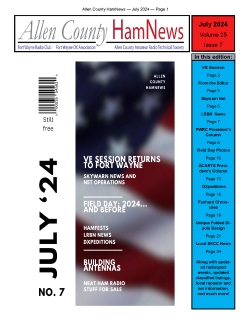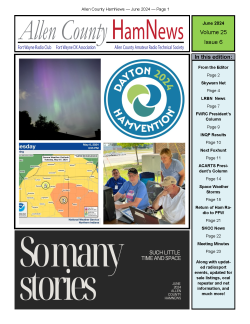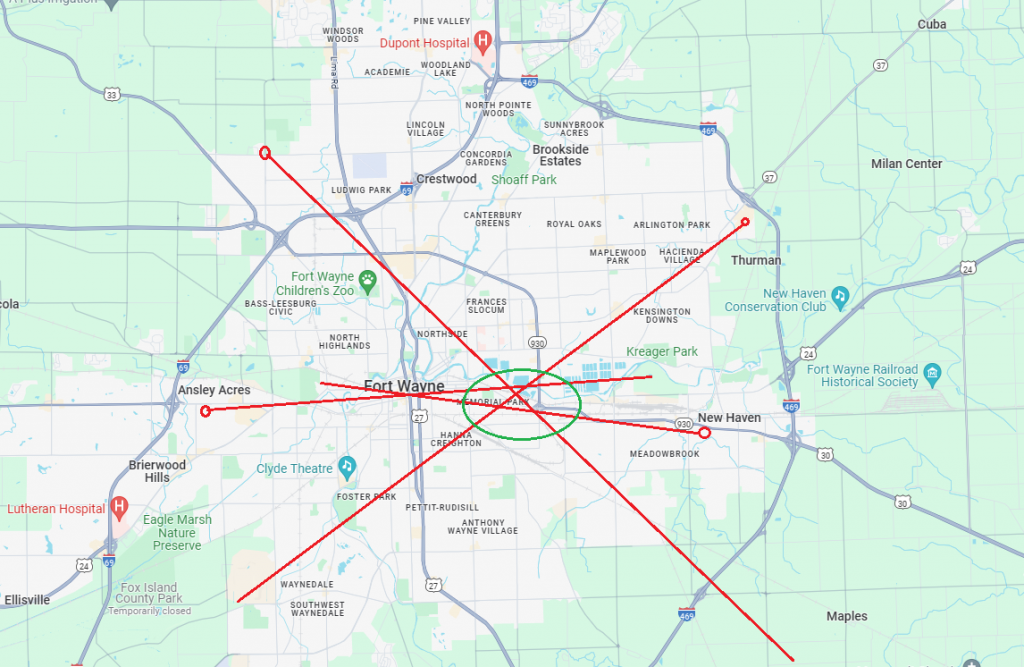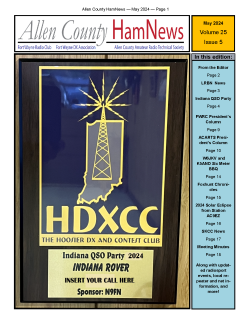
The July 2024 issue of Allen County HamNews is available for download from this website using the link below or the “Newsletters” menu item above.

The July 2024 issue of Allen County HamNews is available for download from this website using the link below or the “Newsletters” menu item above.

The June 2024 issue of Allen County HamNews, the official newsletter of the Fort Wayne Radio Club, is available for download. Use the link below or the “Newsletters” menu item above.

The Fort Wayne Radio Club is trying a new approach to fox (hidden transmitter) hunting. Instead of teams competing against each other, all hunters will be part of one, large team that works together to find the fox. In a real life situation, a stuck transmitter or bootlegger would need to be localized quickly to find the signal’s origin.
Here’s how the new procedure will work:
At the beginning of a hunt, instead of all hunters starting from a central location, we will position hunters around the county, ready to take a bearing on the fox.
One person will plot bearings provided by multiple hunters, who could be mobile or home stations with directional antennas. Their information will enable the drawing of vectors that should converge on the approximate location of the fox (see image above).
Once a possible solution is evident, the coordinator will direct mobile stations to locations closer to the fox’s apparent location.
When the fox transmits again with hunters closer, the process repeats and the solution narrows.
If a hunter finds the fox’s location, all others hunters will be informed.
At the fox’s location, hunters will try to find the micro fox. Equipment will be shared and newbies taught how to use it. This will be a good learning experience for all.
For the conclusion, successes, failures, and suggestions for improvement will be discussed by all so that future hunts can include other technical challenges, etc.

The May 2024 issue of Allen County HamNews, the official newsletter of the Fort Wayne Radio Club, is available for download from this website using the link below or the “Newsletters” menu item above.

The April 2024 issue of Allen County HamNews, the official newsletter of the Fort Wayne Radio Club, is available for download using the link below or the “Newsletters” menu item above.

The March 2024 issue of Allen County HamNews, the official newsletter of the Fort Wayne Radio Club, is available for download using the link below or the “Newsletters” menu item above.
The ARRL reports that two US Senators Roger Wicker (MS) and Richard Blumenthal (CT) introduced a bill that would eliminate homeowner association land use restrictions that prohibit, restrict, or impair the ability of an Amateur Radio Operator to install and operate amateur station antennas on residential properties they own. Read more on the ARRL website.
The Associated Press reports that someone stole the 200-foot vertical antenna of an Alabama AM broadcast station. Read more on the Associated Press website.
The ARRL reports that an amateur radio transmitter that the Japan Aerospace Exploration Agency placed on the moon has been transmitting Morse code on 437.41 MHz since January 19. Read more on the ARRL website.

The Fort Wayne Radio Club will host a carry-in chili competition and social for our February 9 meeting. The cook whose chili gets the most votes from attendees will win a $50 cash prize. The club will accept votes only from people who tasted the chili for which they vote.
All club members are invited to bring their best chili or a favorite side dish or beverage.
Members who intend to bring chili are requested to advise Joe Stephens via email by Wednesday evening, Feb. 7. Email him at kd9nyz@gmail.com.
Club leaders request that chili cooks label their creations with a heat designation; mild, medium, hot, or “temperature of the sun.” Nobody likes to be surprised by a burning tongue!
The club asks cooks to arrive at around 6 p.m. with their chili in a crock pot and some sort of serving utensil, such as a ladle. The meeting will begin at 6:30.
During the business portion of the meeting, the club plans to discuss creating an Elmer corps for new hams and the future of fox (hidden transmitter) hunting competitions.
As usual, the club will meet at Good Shepherd United Methodist Church, 4700 Vance Ave., Fort Wayne. Enter the church building using door number 2. If possible, arrive no later than 6:30 p.m., so someone will be at the door to let you in. Late arrivals might need to call for assistance on the 146.76 MHz FWRC repeater. Once inside, proceed to Raasch Hall.